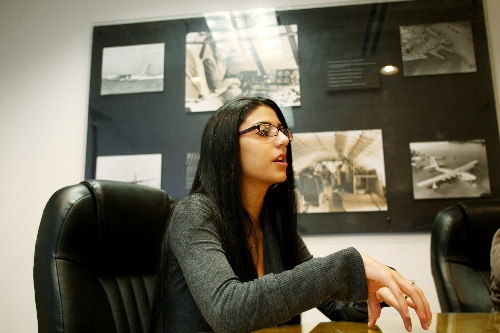UNLV budget axe could cut entire programs
A single lecture in an introductory communications studies class at UNLV can have more than twice as many students in it as the entire department of informatics does.
That helps explain why informatics is listed as the university's most expensive program and communications studies its least expensive.
Administrators considering how to implement the next round of budget cuts at the university say they will likely focus on the elimination of programs, rather than institution-wide cuts as they've done before.
A main criteria for figuring out which programs to cut is how much they cost.
A list of the 20 most expensive programs -- when measured by how much they cost divided by the number of full-time students enrolled -- made the rounds at the university last month, and it quickly became infamous. Students are worried. Faculty are worried. Administrators are frustrated.
Computer science is on the list. Journalism. Educational leadership. Mechanical engineering. The people in charge of the programs are being asked to defend their program's existence, explain why they should not be eliminated, and give the reasons for their cost.
At the top of the list, informatics had a 2009 budget of just under $600,000, according to figures provided by the university. That divided out to about $31,000 per full-time student.
At the bottom is communications studies, which has a per student cost that runs about $1,630.
How can one program cost 19 times more than another?
Volume, time and changing numbers.
A relatively new, growing program
Informatics is a hybrid program, a combination of information technology and some other field, such as business. It's housed in the college of engineering.
It is a relatively new program at the University of Nevada, Las Vegas, admitting its first class in 2007. It's becoming a popular offering at universities nationwide. Hal Berghel, the program's director, said there were no informatics programs in 2000. There are about 75 now.
He said the university added it after local industry leaders encouraged it. There is a local shortage of experts who can integrate information technology with industry, which often meant hiring people from outside the area, which can be expensive.
Marilyn Tabet, who moved to Las Vegas with her family in 2003, said she had always been interested in technology. So, when she graduated high school in 2007, she wanted to pursue Web design at UNLV.
But then she heard about informatics. She took a class and loved it.
"I was intrigued," she said. "I never thought I'd enjoy it so much."
She plans on graduating soon, and is on the verge of getting an internship with a local resort. She hopes to turn that into a full-time job working on its Web site.
Student Anonh Ratsamy started out at UNLV studying computer science, then information technology. But he liked the interdisciplinary nature of informatics, so he switched.
He wants to go into the cybersecurity field, perhaps law enforcement, so he is combining his computer courses with business law and criminal justice classes.
Combining computer studies with another field of study is what informatics is about. It is vital in today's technology driven world, Berghel said.
But establishing a new program meant hiring new people. Informatics has four faculty members, who account for the bulk of its cost. At first, the program had only a few students, so the per student cost was high.
The infamous list measured costs using the 2009 budget and 2008-2009 student figures.
But, when a program is growing as fast as informatics is -- it is up to 75 students now -- per student cost plummets, Berghel said.
According to information provided by the program, the cost this semester is down to $14,000 per full-time student, less than half what it was a year ago. And, they say, as the program continues growing -- if it is allowed to -- those costs will continue to drop.
"The only way a brand new program is cost effective is if the incoming freshmen teach each other," Berghel said.
He is frustrated knowing that the program could be cut before it's given a chance to thrive.
"This is extremely demoralizing," he said.
'Communications is everywhere'
They have quite a different story in the department of communications studies, a long established program with hundreds of students majoring in it and many more taking its introductory classes.
The program catches all types, from those who plan on studying communications further and going on to graduate school to those who think it will be a useful degree in today's job market.
These include future lawyers or future public relations professionals.
Like Amanda Pinney, a graduate student.
She already has a degree in business, and had a good job at the Baseball Hall of Fame near her hometown in upstate New York.
But she wanted more. She came to UNLV looking for a program with a broad area of study. Communications skills seemed to fit the bill.
She is working toward her master's degree now, and hopes to get into public relations or marketing when she graduates.
"I think this will be a great combination with my undergraduate degree," she said. "Communications is everywhere. No matter what you do, essentially everything is based in communications."
The basics: Communications studies is what used to be called speech in school. Students learn about the different ways people communicate with each other. They study political speeches, relationship communications, boss-employee relationships and the like.
The department has more than 350 undergraduate students, 18 to 20 graduate students, nine permanent faculty, three visiting faculty and eight graduate assistants who also teach.
Program director Tom Burkholder said there are a couple reasons it costs so much less than other programs.
First, it is fairly large and has a broad appeal. Every year, about 1,800 students take Communications 101 and about 1,000 take Communications 102, the introductory courses.
Not only do communications studies majors have to take these classes, it's a requirement for several other majors and a recommendation for others.
In addition, Burkholder said, the department underwent some changes about five years ago to save money.
Instead of having professors teach relatively small classes in the intro courses, the format was changed to very large lecture halls with 160-plus students. Graduate assistants teach the labs.
The new system allowed each professor to teach more students than before, and reduced the department's reliance on part-time faculty, which cut expenses.
Burkholder acknowledged that not every department can do this. There must be wide appeal, for one. And the subject matter must lend itself to large lectures. Courses heavy on writing assignments also wouldn't work. How would the professor grade 160 research papers?
Contact reporter Richard Lake at rlake@reviewjournal.com or 702-383-0307.
2009 UNLV Expenditures





























